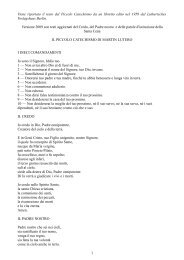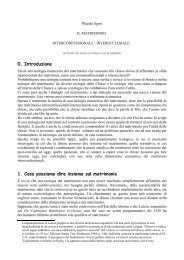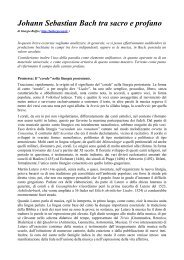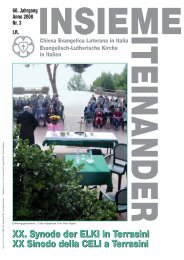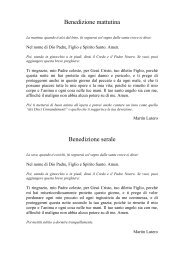Il dialogo ecumenico e interreligioso: quale futuro? - Nemesistemi
Il dialogo ecumenico e interreligioso: quale futuro? - Nemesistemi
Il dialogo ecumenico e interreligioso: quale futuro? - Nemesistemi
Create successful ePaper yourself
Turn your PDF publications into a flip-book with our unique Google optimized e-Paper software.
stessa della preghiera, la rete del monastero invisibile 1 . Così, l unità detta prioritariamente<br />
visibile trova la sua assise più consistente nel monastero invisibile ... E si ritrova così anche la<br />
radice originaria, fino alla congiunzione con l «l ecclesia ex judaeis» e prima delle fratture storiche,<br />
dell intuito monastico stesso 2 .<br />
QUALE SANTIFICAZIONE: NELLA PREGHIERA PER L UNITÀ O NELLA PREGHIERA<br />
COMUNE?<br />
La preghiera rimette l'intento <strong>ecumenico</strong> nella prospettiva del 'mistero della Chiesa' 3 . La<br />
preghiera per l unità ha conosciuto momenti di crisi che potrebbero essere -addirittura- quelli della<br />
preghiera stessa 4 , conferma che la questione della preghiera comune o della preghiera per l unità<br />
superano gli alti e bassi della incognita ecumenica stessa. Essa è 'riflesso della comunione del Padre<br />
con il Figlio per mezzo dello Spirito Santo' 5 . Ogni preghiera autentica viene suscitata dallo Spirito<br />
e ciò in ogni persona umana disponibile 6 . Questo mistero di comunione è un 'mistero di santità'.<br />
L unità non può essere che una unità di santificazione 7 . La preghiera è anelito di santità 8 . La<br />
santità significa, in una parola: "diventa ciò che sei" 9 ! Essa sarà vissuta come un cammino<br />
(pellegrinaggio) di santificazione 10 . <strong>Il</strong> filo conduttore della santità è l'Amore 11 . La via dell'Amore -<br />
dalla sua sorgente nel mistero di Dio 12 - è l'unione 1 . La santificazione è l unità ricreata -<br />
the first time an Octave of Prayer for Church Unity from 18-25 January in Graymoor, Garrison, New York. The Rev. Paul Wattson and Mother<br />
Lurana White, co-founders of a small religious community in the Franciscan tradition known as the Society of the Atonement, chose for the octave<br />
the days spanning from what was at that time in the Roman Catholic calendar the "feast of the Chair of Peter", to the "feast of the conversion of Paul".<br />
In celebrating its 100th anniversary, this year's Week of Prayer for Christian Unity points to that historical milestone as its foundational moment. But<br />
it is clear that a lot has changed in the ecumenical landscape over the last century. The Octave of Prayer for Church Unity of those days was based on<br />
a concept of unity as re-union of Christendom under the Pope's authority. For that reason, the octave was neither appealing nor theologically<br />
acceptable for Christians and churches outside the Roman Catholic Church, except for some Anglicans who were sympathetic to the idea of a reunion<br />
of Canterbury with Rome<br />
like Wattson and White, who joined the Roman Catholic Church themselves. While it soon became widely observed in<br />
the Roman Catholic Church, the octave was by no means the only initiative of prayer for church unity at that time. Well before 1908, the World<br />
Evangelical Alliance, the World Student Christian Federation, the Young Men's Christian Association together with the Young Women's Christian<br />
Association, had already all launched worldwide annual weeks or days of prayer in which the aspect of unity played an important role. As early as<br />
1907 the London-based Times published a letter signed by an impressive list of high-ranking church leaders from different denominations, who called<br />
on "all the Christian ministers of religion in England [ ] to prepare their congregations for a united effort of prayer on Whitsunday [ ] for the<br />
reunion of Christians". They underlined that those prayers should not compromise the beliefs of any confession but should focus on God's will for the<br />
unity of all. The church leaders soberly declared that it was not yet the time for large schemes of corporate reunion but that churches should unite in<br />
penitence and prayer: penitence for their divisions and prayer for opening their minds to God's will for unity. "God's will for the unity of all" became<br />
something like the leitmotif of the Week of Prayer for Christian Unity through the years. Early writings of the Faith and Order movement on prayer<br />
and unity refer to that concept. Decades later, that formula made it possible to pray for unity within the Roman Catholic Church in a way that would<br />
not hurt denominational loyalties of other Christians. And even today it is a reminder to Christians and churches everywhere that the quest for the<br />
unity of all does not depend nor is it based on different doctrinal concepts of unity; it is rather God's will for the entire creation».<br />
1 M. Villain, Introduction à l oecuménisme, Paris 1960, pp. 188-193; G. Curtis, 'Paul Couturier and Unity in Christ', in «Internet» 2006,<br />
http://paulcouturier.faithweb.com/invisiblemonastery.html: «'The Invisible Monastery consists of the company of souls to whom, because they have<br />
tried truly to expose themselves to his flame and thus to his light, the Holy Spirit has been able to make known intimately the sorrowful meaning of<br />
the separations between Christians - those in whom such knowledge has engendered permanent suffering resulting in habitual prayer and penitence.<br />
This fellowship is invisible in its totality, for it is scattered among all Christian communions. In some cases its members are isolated. In others they<br />
are found in groups corresponding to their temperaments and their tastes. Sometimes these individuals or groups are in relations more or less visible,<br />
more or less frequent one with another, but the reality in its full number remains always invisible, being always hidden with Christ in God. The name<br />
of Monastery does nevertheless belong to this unity, because it is the same suffering, the same desires, the same pre-occupations, the same spiritual<br />
activity, the same goal which gather together in the heart of Christ this multitude drawn from every nation. . . . Enclosure there is none save that found<br />
through dwelling in Christ - his prayer for unity. The spirit is that of this Prayer Universal; the action is spiritual emulation developed in every<br />
direction'».<br />
2 J. Willebrands, Le rôle du monachisme dans le mouvement oecuménique, in «Unité des chrétiens», 1973 nº 2, p. 17.<br />
3 Y. Congar, The Theology of Prayer for Unity, in «One in Christ», 1967 nº 3, pp. 268-269.<br />
4 J. Hamer, Rapport du Secrétaire du Secrétariat pour l unité des chrétiens, in «Information service», 1972 nº 17, p. 6.<br />
5 Cfr l'intervento di N. Nissiotis all'incontro di FEDE E COSTITUZIONE, in A. Romita, La preghiera per l'unità dei cristiani, in «Nicolaus», 1994 nº<br />
1-2, p. 181.<br />
6 Cfr Giovanni Paolo II ad Assisi, il 27 ottobre 1986, in idem, Discorso ai cardinali della Curia del 22 dicembre 1986, in «Bulletin du Secrétariat<br />
pour les non chrétiens», 1987 nº 64, p. 69; COMMISSION INTERNATIONALE POUR LE DIALOGUE INTERRELIGIEUX, Contemplation et vie<br />
monastique, in «La documentation catholique», 1994 nº 2090, p. 292.<br />
7 W. Kasper, Contro i profeti della sventura. La visione del Concilio per il rinnovamento della Chiesa, in «Communio», 1990 nº 114, p. 68.<br />
8 Y. de Moncheuil, Aspects de l'Eglise, Paris 1958, p. 52.<br />
9 M. Labourdette, La sainteté, vocation de tous les membres de l'Eglise, in G. Barauna, L'Eglise de Vatican II, Paris 1967, vol. III, p. 1109.<br />
10 A. Huerga, La peregrinación como prática penitencial, in «Jubilaeum», Città del Vaticano 1974, p. 385.<br />
11 M. Labourdette, La sainteté, vocation de tous les membres de l'Eglise, in G. Barauna, L'Eglise de Vatican II,Paris 1967, vol. III, p. 1115; P. Tillich,<br />
Love, Power and Justice, London 1954, p. 77; P. Teilhard de Chardin, L'activation de l'énergie, Paris 1963, pp. 54, 78; idem, Science et Christ, Paris<br />
1965, pp. 214-215; S. Bulgakov, Le Paraclet, Paris 1943, p. 307.<br />
12 U. Hedinger, Der Freiheitsbegriff in der Kirchlichen Dogmatik Karl Barths, Zürich 1962, S. 37; F. Gogarten, Die Frage nach Gott, Tübingen 1968,<br />
S. 75; K. Barth, Kirchliche Dogmatik,Zürich 1975, B. II, 1, S. 35; P. Teilhard de Chardin, L'avenir de l'homme, Paris 1959, p. 75; idem, Science et<br />
Christ, Paris 1965, p. 215.<br />
4



